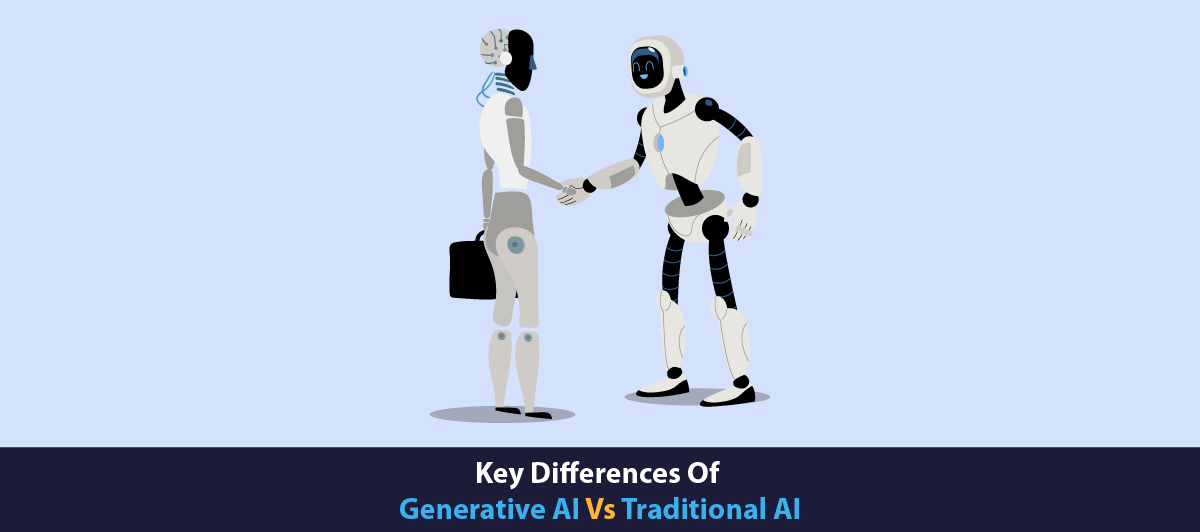Generative AI Vs. Traditional AI: Which is Better?
Quick Summary: Generative AI surpasses traditional AI in terms of creativity and adaptability. In today’s world, the versatility and innovative nature of AI-enabled technology makes it a top choice. But which to choose in between Generative AI Vs. Traditional AI? Read this blog and understand the in-depth comparison of these two same but different techs.
Introduction
In the evolving field of artificial intelligence, the debate between generative AI and traditional AI has led to heated discussions among experts and enthusiasts. Both approaches provide powerful and different functionality for, but the question is which is better Generative AI Vs. Traditional AI?
Generative AI tools have captured attention around the world with its ability to innovate, mimic human creativity, and innovate in areas as diverse as art, music and storytelling Its ability to create realistic images, compose music and even write the compelling narrative pushes the limits of what the AI can creatively achieve. It has the ability to produce text, images, and music makes it extremely valuable for a variety of applications. It includes manufacturing, design, and even scientific research.
On the other hand, traditional AI, which focuses on rules, logic and specific tasks, has been the backbone of AI applications in sectors such as finance, healthcare, logistics and others.
In this article we will discuss their respective contributions to the AI landscape and provide insights into which approach may be most appropriate for different situations. Join us on this journey to unlock the exciting world of AI innovations and discover the path that leads to the greatest breakthroughs in artificial intelligence.
Let’s have a look at an in-depth comparison of these technologies! And decide which one would be best for your next Artificial Intelligence Development project!
Overview To Generative Artificial Intelligence
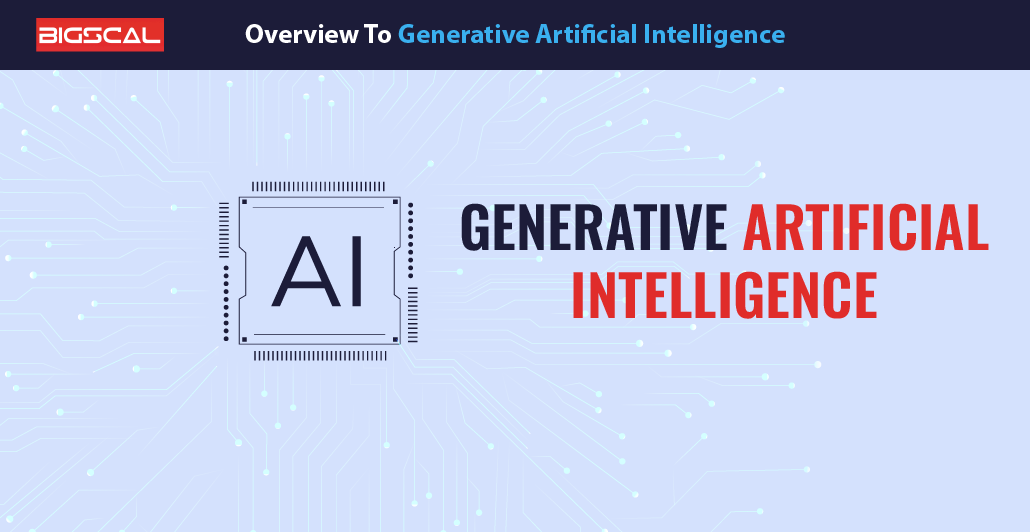
The main focus of the Generative AI industry is to develop intelligent systems that stand in for the human operators. These algorithms work most frequently by using the models of deep learning. As GANs (Generative Adversarial Networks) and VAEs are concerned, they can generate various types of data. This includes images, text, music, etc. deep generative models are the perfect way to learn patterns and trends by analyzing big data; thus, new features appear.
Besides this, Generative AI algorithms are role-playing in creative industries like artwork production and the composition of music. For the data that is trained to model machine learning, there are ethical dilemmas about the use of such data. These concerns include generating false images known as deep fakes and a kind of bias referred to as output biases. Moreover, the research also highlights the crucial role of green technology integration. It also includes unfailing implementation, monitoring, and evaluation of policies.
Advantages Of Generative AI
- Creativity
- Personalization
- Efficiency
- Adaptation
- Scalability
Disadvantages Of Generative AI
- Data reliance
- Ethical concerns
- Algorithmic bias
- High resource consumption
Overview To Traditional Artificial Intelligence
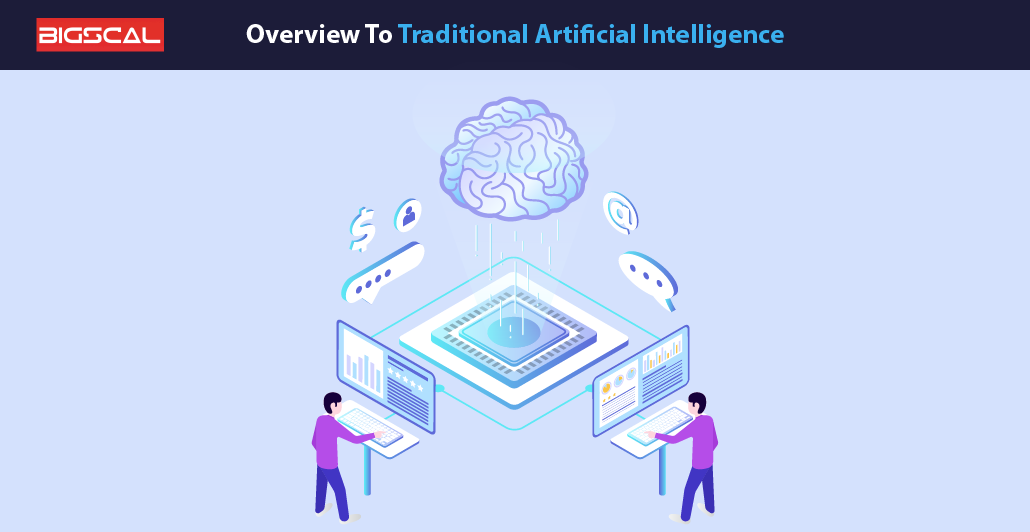
Traditional artificial intelligence (AI) was the term that is to depict bottom-up algorithms that emphasized rule-based systems and symbolic understanding. They depended on the use of regulations and existing information to deduce decisions and implement actions. They lacked the flexibility to exploit the gap in the market; mostly they were incompetent to handle ambiguity, complexity, and uncertainty while developing content.
The machines as such were like the expert systems which used the rule-based logic in order to depict one specific area with the same clarity as human beings. Despite the fact that these methods were extremely repetitive and systematic. The flexibility and adaptability of artificial intelligence (AI) are now a reality, thanks to the evolution of machine learning and deep learning methods in AI for wider applications and models.
Advantages Of Traditional AI
- Clear logic
- Efficiency
- Reliability
- Interpretable results
Disadvantages Of Traditional AI
- Limited flexibility
- Lack of context.
- High development and maintenance costs
- Relying on large datasets
- Difficult to deal with uncertainty
Applications Of Generative AI Model
After understanding the basics about the GAI, which basically follow large language models. So, let’s have a look at its generative AI applications:
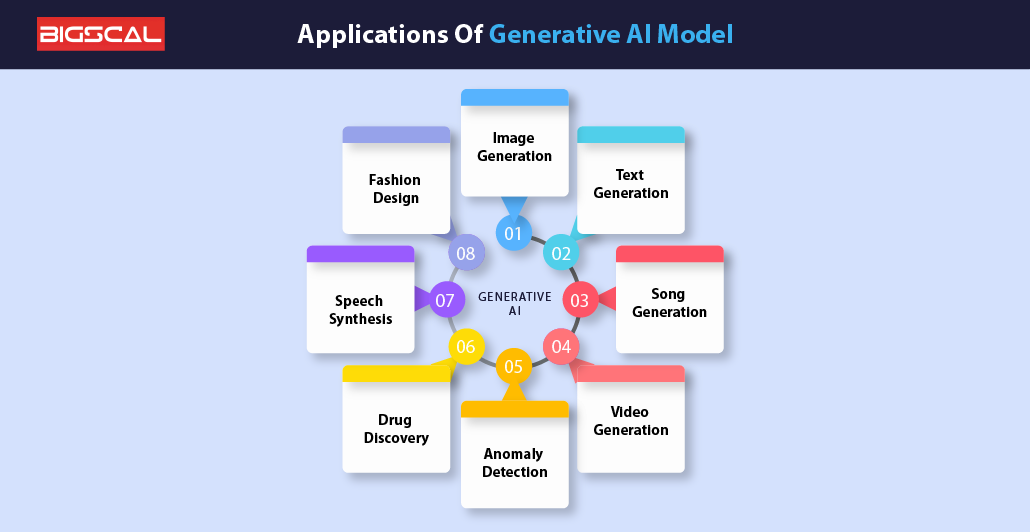
Image generation
Types of models for generating images now include GANs and VAEs. These generative models are capable of producing realistic pictures. They are usable in scores of various areas like design of AI models, pattern recognition enhancement for machine learning and optimization of image templates.
Text generation
GPT3, 3.5 (Generative Pretrained Transformer), and other similar systems provide consistent and context-sensitive text. It also gives the possibility to complete real-life scenarios. It can be a part of essay writing, web search, sentence generation, content creation, and even code generating.
Song Generation
Generative models let you write compositions in any styles and genres.
Video Generation
Generative models with a high level can also be trained to generate visual videos when text is provided. It accounts for video editing and special effects, animation and virtual reality as commonly known uses.
Anomaly detection
One can use Generative models to study the regularity in the distribution of normal data. So as to find out the differences from normal distribution, also popular as outliers or anomalies. It is effective in identity fraud, network safety and quality control.
Drug discovery
Researchers use GAI in drug discover. The inventive drug can be an attractive novel agent possessed of good characteristics. It is found in drug development, material science, and medicine.
Speech synthesis
Models that enable inhuman speech. This latter is being applied in a virtual assistant, voice-broadcasting, and accessibility tools for the visually impaired.
Fashion Design
Generative models of plastic surgery can generate anything, from unique clothing designs, patterns to the latest styles. Thus, it manifests in the fashion industry wherefore it helps designers decide on what is trending now and turn the trends in generative AI into the source of inspiration for the future fashion styles.
Game Development
Generative models can allow virtual environments, residents, characters, and tales in games. Used for procedural content generation and the game development for scripted stories.
Measurement and prediction
Generative models can not only simulate complex systems but also uses the created outcome to draw predictions. It is essential for weather prediction, predicting the traffic and modeling the economic conditions.
Applications Of Traditional AI Models
Information AI models refer to rule-based systems, expert systems, and early ML techniques that existed before deep learning revolutionized. Here are some applications where traditional AI models:
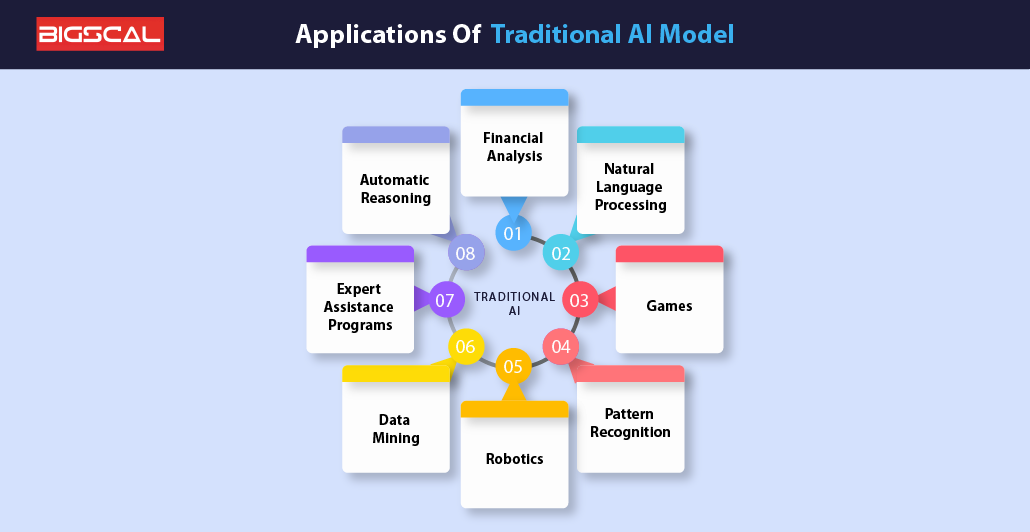
Expert systems
It’s a knowledge-based system whose principle is to make the same decisions as a human expert by applying the rules specific to the particular field. This tool has application in various areas of medicine (such as diagnostics), economics (in risk assessment) and engineering (in problem-solving).
Natural Language Processing (NLP)
Mainstream AI solutions like rule-based techniques, grammar analyzers, etc. have already been used for such applications as syntactic analysis, language translation, and text extraction among others.
Games
AI methods as least decision trees, zero algorithms and alpha-beta pens can be found used to help gamers who are just intelligent in these board games like chess, checkers and Spanish backgammon to make appropriate decisions in the games.
Pattern recognition
Approaches like clustering, recognition, and regression are recognized as successful in recognitory pattern tasks like handwriting recognition, speech processing, and image processing.
Robotics
Traditional AI models applied in robotics are responsible for many tasks, including route finding, obstacle avoidance, and manipulation of objects in constrained and controlled environments.
Data mining
Algorithms like association rule mining, clustering and classifications have been populated in data mining in lieu of deriving patterns, trends and insights from a large set of data.
Expert assistance programs
Noting regions possessed of the necessities of legal issues which require acquiring a comprehensive knowledge and expertise, expert programs were employed for legal advice, case strategies, using documents.
Automatic Reasoning
Classical AI intelligent machines used for automated reasoning systems to analyze complicated data, fasten logical thinking and prove theses, and make decisions according to the stored logical rules.
Financial Analysis
Applications such as decision trees, neural networks and regression analysis have been successful in the respective instances of decision support, fraud detection and investment forecasting in the financial sphere.
Healthcare
Healthcare has involved the implementation of advanced algorithms and machine learning to assist in diagnosis, treatment planning, patient management, and medical images classification.
The Key Differences Generative AI and Traditional AI As Per Their Applications
Here are some major differences between Generative and Traditional AI. It is important to understand Generative AI Vs. Traditional AI. Have a look:
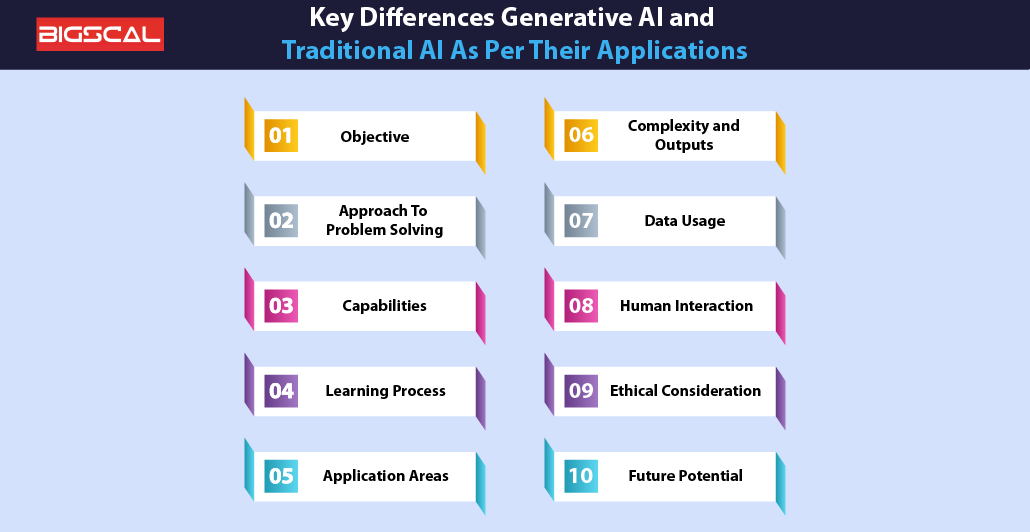
Objective
Generative AI focuses on innovations such as images, text, or music. These data resemble human like data. It aims to be real and indistinguishable. In contrast, traditional AI tends to focus on specific tasks, such as classification, prediction, or decision-making, based on pre-defined rules or protocols.
Approach To Problem Solving
Generative AI uses techniques such as neural networks, generative adversarial network GANs, deep learning, etc. to generate new data using learning algorithms and features from existing data. This includes training models to hear the underlying structure of the data is underlined and plotted.
On the other hand, Traditional AI relies on algorithms and pre-defined rules to solve problems based on explicit guidelines.
Capabilities
Generative AI technology particularly includes the ability to create and recreate an assortment of items. By this, it is suitable for jobs like imagined synthesis, text generating, and artistry.
However, with Traditional AI, things become balanced as you are able to carry out tasks with patterns, decisions and problems as long as they are in pre-defined boundaries.
Learning Process
Generative AI learns from self-training or latest learning feature. This is the site, via unlabeled or semi-labeled data, where the generator AI systems are trained to determine the major features. While it also does reinforcement learning, too, for the process of optimization. Use our AI to write for you about any topic!
Differing from traditional AI that only works with supervised learning and labeled data, New form AI focuses on generative models, unsupervised learning with raw data, and reinforcement Learning. If this kind of model is adopted, there is a potential for a high I/O mapping.
Application Areas
Even though you have the implications of both that makes the intelligence to be artificial hat have been discussed in this article. Well, but as an illustration, let’s watch it for a second. Generative AI program is a useful tool that can help to compose new things, including images, texts, and music. It is compatible with artistic tasks like production of art, storytelling, or other material.
Unlike Traditional AI which focuses on automated problem solving, Decision making tasks Creative AI models are designed to mimic the imagination of a human brain. The main difference is due to the fact that the productive part of the application involves making something new, and the exploratory part is just investigation or taking advantage of what already has been created.
Complexity and Outputs
Users of generative AI models accomplish generation of complex and diverse output sets. Yet, the same machines that beget massive employment losses also continue to create many new job opportunities. This is inclusive of large datasets of images, hyperspectral or audio data used to generate GNNs (Generative Adversarial Networks).
However, the difference between the customized AI models and the traditional AI models is that they are able to process crucial training data as long as such training data falls within pre-defined data sets and algorithms. It cuts the multi-variable and interdependency features, and this reduces the capacity of existing resources.
Data Usage
Many Generative AI models use data differently compared to traditional AI. While traditional AI models primarily rely on historical data to make predictions or decisions. Generative AI models use data to find underlying patterns and develop new features. This includes finding distributions of data points and developing new models based on those known distributions.
Human Interaction
Generative AI systems generate new elements such as images, music, or text to mimic human creativity and decision-making processes. These systems often receive human input during the training process, where they learn from information and feedback provided by humans.
In contrast, traditional AI are foundation models. It focuses more on predetermined rules and regulations, with little or no direct human interaction during operations.
Ethical Consideration
Ethical considerations in Generative AI Vs. AI revolve around data privacy, impartiality in generated content, and possible ethical considerations of AI-generated content, etc.
In contrast, Ethical concerns about traditional AI are common focuses on transparency, accountability, and fairness in decision-making processes especially in applications such as automated decision-making.
Future Potential
Generative AI has tremendous potential in various fields such as art, entertainment, medicine, education, where creativity and innovation are mandatory.
Real-world Examples
Examples of generative AI include DeepMind’s AlphaGo, which generates moves in a game of Go, and Open AI GPT model, which generates human-like information.
Traditional AI examples include IBM’s Watson for natural language processing and recommendation systems used by companies such as Amazon and Netflix. This real-world application illustrates how both generative and traditional AI contribute to a variety of technological breakthroughs.
Generative AI Vs. Traditional AI: Which is Better?
A dispute on Generative AI vs. traditional AI is on their equally strengths and mighty qualities and fields of use. The classical AI, that is based on a rule-based system and machine learning algorithm, that were getting amplified through these predefined rules or patterns. Deep learning technology is very versatile and it is efficient in areas such as image recognition, nature language processing and recommendation systems.
While the Discriminative model has vocabulary and syntax as its subjects. The Generative model places more emphasis on the models such as GPT (Generative Pre-trained Transformer) You can use it to generate trillions of sentences by studying the patterns from the data.
The decision whether to apply reproductive AI or traditional AI design relies on the particular requirements and outcomes in the specific context.
Briefly put, both generative AI work and traditional AI are not superior to each other. Its effectiveness, rather, depends more on the circumstances, purpose, and requirements of this particular job or whatever might be assigned. While some firms can focus on either an onshore or offshore strategy, more often than not, a combined approach of both the strategies can let businesses gain immensely from the advantages of both the strategies and hence, give better solutions. So, if you want to go with one Hire AI Developers or company.
Conclusion
The two types AI types of AI, Gen AI and traditional AI, each have their own pros and cons. Whether the decision is based on the special needs of the application or not, maintaining the appropriate level of security is critical. Generative AI is A-lister in the creative designing and addressing problems scenarios. Choose the one that fits best with your needs or you can use both. So, hope now you understand which is best in Generative AI Vs. Traditional AI.
FAQ
What are recurrent neural networks?
Recurrent neural networks (RNNs) are a set of neural networks are for sequential data processing, capable of retaining memory over time. It makes them suitable for tasks such as language modeling and time series prediction.
What is image to image translation?
Image-to-image translation works in machine learning where an algorithm converts an input image from one domain (e.g. style, color) to another domain, such as a sketch to a virtual image.
Can Generative AI handle multiple tasks?
Yes, Generative AI can handle multiple tasks through models like GANs (Generative Adversarial Networks) or multitask learning methods that simultaneously generate different task outcomes.
What is diffusion model?
The diffusion model is a mathematical model. You can use it in cognitive psychology to describe decision-making processes. It represents how information accumulates over time to make choices based on noisy evidence.
What is generative AI in simple terms?
Generative AI recognizes patterns from existing data and creates new content, such as images, text, or music. It provides realistic products that mimic human creativity and can be used in a variety of applications.
